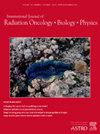From Face-to-Face to Digital Spaces: A Critical Look at Patient Satisfaction with Telehealth in Cancer Care
IF 6.4
1区 医学
Q1 ONCOLOGY
International Journal of Radiation Oncology Biology Physics
Pub Date : 2024-10-01
DOI:10.1016/j.ijrobp.2024.07.026
引用次数: 0
Abstract
Purpose/Objective(s)
Telehealth encounters offer a convenient alternative to traditional healthcare access, mitigating infection risk and providing a critical safeguard for immunocompromised patients, such as those undergoing oncology treatment. Despite its growing usage, there is a lack of research on telemedicine’s impact on the quality of healthcare delivery. In this study, we provide a comprehensive analysis of our institutional data, highlighting the impact of telehealth on patient satisfaction relative to a carefully matched cohort of in-person encounters.
Materials/Methods
A 14-item CMS approved Patient Satisfaction (PS) survey was administered to patients at four outpatient academic radiation oncology centers from May 2021 to November 2023. Four survey questions were analyzed: team member listened, team member explained, enough input in care, and the likelihood of facility/provider recommendation. The likelihood of recommending the facility and/or provider was gauged on a 0-10 scale, with 9-10 indicating a higher likelihood of endorsement. Responses to the other questions were measured on a 0-4 Likert scale, where 4 signifies “Yes, definitely”, indicating satisfaction for the given question. A previous analysis has identified five key factors that independently influence PS: Area Deprivation Index (ADI), gender, cancer diagnosis, treatment intent, and survey visit type. Based on these findings, a matched pair analysis was conducted, ensuring participants were paired based on these criteria to accurately assess the impact of telehealth on PS. Univariate (UVA) and multivariable (MVA) logistic regression analyses determined the impact of these factors on recommendation scores.
Results
Out of 7,501 collected surveys, 528 (7%) were collected from telehealth encounters. After matching, patients in the telehealth group reported less satisfaction across all questions, including team member listened (P < 0.001), team member explained (P < 0.001), enough input in care (P < 0.001), facility recommendation (P = 0.003), and provider recommendation (P = 0.012) compared to in-person visits. MVA highlighted that patients who were satisfied with “enough input in care” (OR = 86.9, P = 0.002) and “team member explained” (OR = 9.3, P < 0.001) were more likely to recommend the facility and the provider.
Conclusion
In this study, we found that patients are overall less likely to report high satisfaction with their telehealth compared to in-person encounters. The factors driving whether patients are likely to recommend the facility or the provider were higher satisfaction with the input they had in their care and whether the provider explained well. Further research is needed to address potential limitations of telemedicine encounters to increase access to health, particularly for patients at risk of severe infections, without compromising overall quality of care.
从面对面到数字空间:癌症护理中远程医疗患者满意度的批判性审视
目的/目标:远程医疗为传统医疗服务提供了一种便捷的替代方式,可降低感染风险,并为接受肿瘤治疗等免疫力低下的患者提供重要保障。尽管远程医疗的使用率越来越高,但对其对医疗服务质量的影响却缺乏研究。在本研究中,我们对本机构的数据进行了全面分析,强调了远程医疗对患者满意度的影响,而这一影响是相对于经过仔细匹配的面对面就诊人群而言的。材料/方法 从 2021 年 5 月到 2023 年 11 月,我们对四个门诊肿瘤放射学术中心的患者进行了 14 项 CMS 批准的患者满意度(PS)调查。对四个调查问题进行了分析:团队成员的倾听、团队成员的解释、对护理的足够投入以及推荐医疗机构/医疗服务提供者的可能性。推荐医疗机构和/或医疗服务提供者的可能性以 0-10 分来衡量,9-10 分表示认可的可能性较高。对其他问题的回答采用 0-4 分的李克特量表,其中 4 分表示 "是,肯定",表示对给定问题的满意度。先前的一项分析确定了独立影响 PS 的五个关键因素:地区贫困指数 (ADI)、性别、癌症诊断、治疗意向和调查访问类型。基于这些发现,我们进行了配对分析,确保参与者根据这些标准配对,以准确评估远程医疗对 PS 的影响。单变量 (UVA) 和多变量 (MVA) 逻辑回归分析确定了这些因素对建议得分的影响。匹配后,远程医疗组患者对所有问题的满意度均低于亲诊组,包括团队成员倾听(P <0.001)、团队成员解释(P <0.001)、足够的护理投入(P <0.001)、设施推荐(P = 0.003)和提供者推荐(P = 0.012)。MVA 强调指出,对 "足够的护理投入"(OR = 86.9,P = 0.002)和 "团队成员解释"(OR = 9.3,P < 0.001)感到满意的患者更有可能推荐医疗机构和医疗服务提供者。促使患者推荐医疗机构或医疗服务提供者的因素是,他们对医疗服务的投入以及医疗服务提供者的解释是否得当的满意度较高。还需要进一步研究来解决远程医疗就诊可能存在的局限性,以便在不影响整体医疗质量的前提下,增加患者(尤其是有严重感染风险的患者)获得医疗服务的机会。
本文章由计算机程序翻译,如有差异,请以英文原文为准。
求助全文
约1分钟内获得全文
求助全文
来源期刊
CiteScore
11.00
自引率
7.10%
发文量
2538
审稿时长
6.6 weeks
期刊介绍:
International Journal of Radiation Oncology • Biology • Physics (IJROBP), known in the field as the Red Journal, publishes original laboratory and clinical investigations related to radiation oncology, radiation biology, medical physics, and both education and health policy as it relates to the field.
This journal has a particular interest in original contributions of the following types: prospective clinical trials, outcomes research, and large database interrogation. In addition, it seeks reports of high-impact innovations in single or combined modality treatment, tumor sensitization, normal tissue protection (including both precision avoidance and pharmacologic means), brachytherapy, particle irradiation, and cancer imaging. Technical advances related to dosimetry and conformal radiation treatment planning are of interest, as are basic science studies investigating tumor physiology and the molecular biology underlying cancer and normal tissue radiation response.

 求助内容:
求助内容: 应助结果提醒方式:
应助结果提醒方式:


